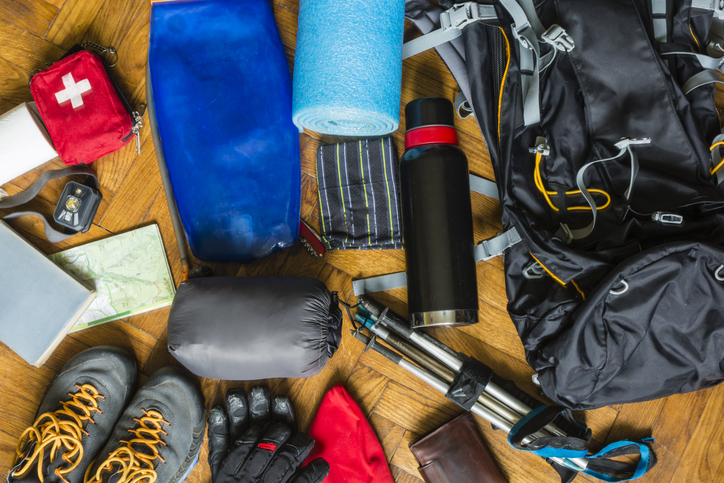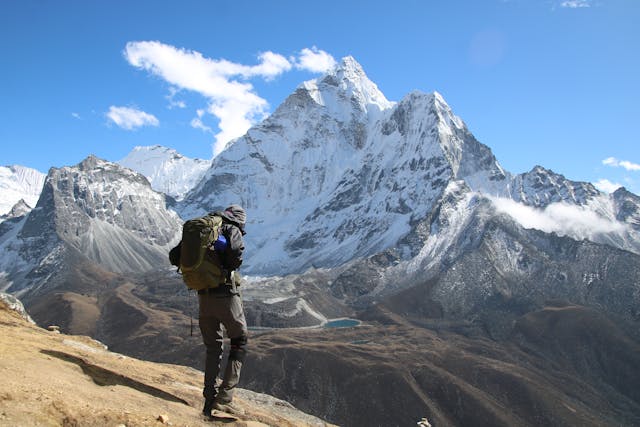Introduction
Planning your first trek in Nepal? Whether your goal is Everest Base Camp, Annapurna Circuit or the Manaslu region, packing the right gear is essential for a safe and comfortable adventure. Our founder Ceri, who recently completed her first Nepal trek, shares a comprehensive Everest Base Camp packing list to make preparing for the Himalayas stress-free.

Everest Base Camp packing list
1) Sleeping Bag
Nights at high altitude can be bitterly cold. You will need a warm sleeping bag, rated to at least -20°C. If (like me) you don’t want to invest in one for your first trek, you can rent a high-quality sleeping bag in Kathmandu for around £10. Ask your trek operator for recommendations.
2) Footwear
- Walking boots are the most important piece of gear. Choose sturdy, comfortable hiking boots. Make sure they are properly broken in before you set off.
- Spare pair of laces — mine frayed at around 5,000m and I was extremely glad to have a backup pair.
- Lightweight trainers or sandals are a welcome comfort to wear after a long day of walking.
3) Clothing Layers
The Himalayan weather can quickly alternate between freezing cold and bright sunshine. Layering is key:
- Good waterproof jacket and trousers for wet days. Top tip: don’t wait until you are trekking to test how waterproof your jacket is!
- Down jacket for cold evenings and higher altitudes. Again, these can be rented in Kathmandu or from your trekking company for about £10.
- Fleece jumper for warmth.
- Fleece lined trousers for even more warmth. These can be picked up very cheaply in Kathmandu and were super cosy to wear in the evenings at high altitude.
- Short sleeved t-shirts – lightweight, breathable and quick drying for day time hiking at lower altitudes.
- Long sleeved thermal tops – again go for lightweight and breathable.
- Trekking trousers – convertible styles with zip-off legs are perfect for the warm lower sections of the trails.
- Quality walking socks — bring at least four pairs.
- Underwear – several pairs of comfortable, breathable underwear.
- Warm gloves for cold mornings.
- Warm hat
- Wide-rimmed sun hat – the sun can be extremely strong at high altitudes. A good sun hat which is lightweight and breathable is vital.
- A neck gaiter or buff is also useful to protect against wind and dust.
4) Packs and Bags
- Daypack (25–40 litres) with rain cover for your daily essentials. The size of your rucksack will depend on whether you are using porters or not. Our trek did so I only took a smaller daypack to carry water, suncream and other essentials.
- Large rucksack or duffel bag (55–70 litres) for porters to carry. A rucksack liner or a thick bin bag inside will protect your kit from rain.
5) Trekking Poles
A good set of trekking poles is invaluable for Everest Base Camp or any steep Himalayan descent. Include them on your Everest Base Camp packing list to significantly reduce the impact on your knees and joints. These are easy to rent in Kathmandu if you’d rather not bring your own.

6) Sun and Weather Protection
The Himalayan sun is fierce, especially at altitude. Pack:
- 100% UV protection sunglasses
- high-factor sunscreen
- lip balm with SPF
7) Hydration
Water in Nepal must be treated before drinking. Bring:
- At least 2 reusable water bottles
- Water purification tablets, drops, or a filtration bottle. For me, water purification tablets were easy to use and worked well.
8) Head Torch
Electricity is limited in lodges, so a head torch (plus spare batteries) is a must for evenings and early starts.
9) Micro-Spikes and Gaiters
If trekking in winter or crossing high passes above 5,000m (like Cho La or Larkya La Pass), pack micro-spikes and gaiters for grip on snow and ice.
10) Personal Items
Your Everest Base Camp packing list should include:
- Microfibre travel towel
- Toothbrush and small toothpaste
- Shower, hair and skincare essentials including tampons/period products
- Deodorant
- Wet wipes – showers are rare at high altitudes
- Antibacterial hand sanitizer
- Toilet paper – at least 2 rolls
- Basic first aid kit including blister plasters, paracetamol and Imodium for any stomach bugs
- Acute Mountain Sickness (AMS) medication – many trekkers carry acetazolamide (Diamox) to help prevent or reduce the symptoms of AMS. Always consult your doctor before travelling to check whether Diamox is suitable for you and follow medical advice on dosage and use.
- Passport
- Copy of travel insurance policy. Make sure your policy covers you for high altitude trekking; many travel insurers consider hiking at altitudes above 3,000 – 4,000m to be an extreme sport and won’t cover it in their policies. For more detail, see our guide on why you need specialist travel insurance for high altitude trekking.
11) Recommended Non-Essential Items
- Sleeping bag liner for extra warmth and to keep your bag clean.
- Safety pins for drying clothes on the go.
- Plastic bags to keep kit dry and organised.
- Camera and power bank – charging in lodges often costs extra.
- A book/kindle and pack of cards for evenings in teahouses.
- Earplugs – teahouse walls are thin and a snoring neighbour is common!
Packing Tips for First Time Trekkers
- Consider renting where possible – Items like down jackets, sleeping bags, and trekking poles can be rented in Kathmandu for a small fee, ask your trek operator for recommendations. For me, renting a good quality down jacket and sleeping bag made sense for my first high altitude trek.
- Layer up – Focus on layers rather than bulky clothing as conditions can change quickly.
- Test your gear – Break in your boots and try out your daypack before you begin.
- Ask your Guide – If you do lose, break or forget anything, speak with your Guide. Ours found me a replacement head torch in a very remote Nepalese village.
Final Thoughts
Packing for a trek in Nepal can feel overwhelming. Balance is key, your Everest Base Camp packing list should include what you need to stay safe, warm, and comfortable without overloading yourself or your porter. Focus on the essentials — sturdy boots, a warm sleeping bag, layered clothing, and good sun protection.
Finding the right travel insurance for trekking can be a painstaking process but we’ve done the leg work for you – view our curated list of insurance policies covering high altitude trekking.
